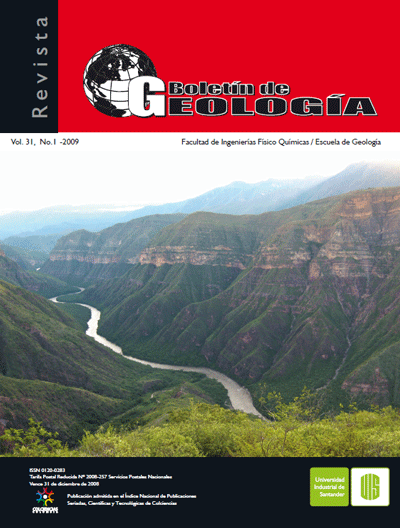DEFORMACIÓN TECTÓNICA RECIENTE EN LOS PIE DE MONTES DE LAS CORDILLERAS CENTRAL Y OCCIDENTAL, VALLE DEL CAUCA, COLOMBIA
Published 2009-07-31
How to Cite
Abstract
The intermountain basin of the Cauca River, located close to the active margin in western Colombia, is one of the keys to understand the evolution and recent seismic activity in the westernmost Andes in Colombia. The discovery of evidences of neotectonic activity in this basin, between Cali and Cartago, and the application of tectonic and radiometric analysis led to the characterization of three zones with distinctive morpho-structural expressions: 1) Foothills of the Cordillera Central. It shows contemporary normal faulting with Miocene deposits that were reactivated as reverse faults during Quaternary, and backthrusts indicating the existence of a subcritical wedge. Radiometric analysis indicate the episodic nature of the neotectonic activity. 2) Foothills of the Cordillera Occidental. The horizontal component of faulting is predominant over the dip-slip one. 3) Floodplain of the Cauca river. Extensional faulting is common on recent fluvial and lacustrine deposits. Sedimentary structures related to faulting suggest that most of them were produced by liquefaction of the substrate during seismic shaking. The topographic gradient, along the Cauca River is not uniform, it shows a higher slope and greater sinuosity in front of the thrust sheets of the Buga Salient. The results of this work are discussed and compared with existing information and a structural model is provided for this area of western Colombia.
Keywords: Active anticline, fold and thrust belt, active blind faulting, liquefaction, Cauca river gradient and sinuosity.
Downloads
References
Audemard, F.A. y De Santis, F. 1991. Survey of liquefaction structures induced by recent moderate earthquakes. Bulletin of the International Association of Engineering Geology, 44: 5-16.
Audemard, F.A. 2002. Ruptura de los grandes sismos históricos venezolanos de los siglos XIX y XX, revelados por la sismicidad instrumental contemporánea, XI Congreso Venezolano de Geofísica, Caracas. Resumen extendido en CD, Venezuela, pp. 8.
Audemard, F.A. 2003. Geomorphic and geologic evidence of ongoing uplift and deformation in the Merida Andes, Venezuela. Quaternary International, 101-102: 43-65
Butler, K. y Schamel, S. 1988. Structure along the eastern margin of the Central Cordillera, Upper Magdalena Valley, Colombia. Journal of South American Earth Science, 1(1): 109-120
Cardona, F.J. y Ortíz, M. 1994. Propuesta de definición de la Formación Pereira y su relación con la Formación Zarzal. Tesis de Pregrado, Universidad de Caldas
Corredor, F. 2003. Seismic strain rates and distributed continental deformation in the northern Andes and three-dimensional seismotectonics of northwestern South America. Tectonophysics, 372(3-4): 147-166.
De Porta, J. 1974. Lexique stratigraphique, Amérique Latine. Colombie (deuxième partie), Tertiare et Quaternaire, V. Centre National de la Recherche Scientifique, Paris
Diederix, H., Gómez, H., Knobzi, J. y Singer, A. 1987. Indicios neotectónicos de la Falla de Ibagué en el sector Ibagué-Piedras, Departamento del Tolima, Colombia, Revista CIAF, Bogotá., pp. 242-252
Ego, F., Sébrier, M. y Yepes, H. 1995. Is the Cauca – Patía and Romeral Fault System Left or Rightlateral? Geophysical Research Letters, 22(1): 33-36
Galli, P. y Ferreli, L. 1995. A methodological approach for historical liquefaction research. In: L. Serva y D.B. Slemmons (Editors), Perspectives in paleoseismology. Association of engineering geologists, Seatle, Washington, pp. 35-48
Hall, M. y Wood, C.A. 1985. Volcano-tectonic segmentation of the Northern Andes. Geology, 13: 203-207
Hanks, T.C. y Kanamori, H. 1979. b values and w-γseismic source models: Implications for tectonic stress variations along active crustal fault zones and the estimation of high-frequency strong ground motion. Journal of Geophysical Research, 84: 2235-2242
Hooghiemstra, H. y Sarmiento, G. 1991. New long continental pollen record from a tropical Intermontane basin: Late Pliocene and Pleistocene history from a 540 m core. Episodes, 14: 107-115
James, M.E. 1985. Evidencia de colisión entre la miniplaca Bloque Andino y la Placa Norteamericana desde el Mioceno Medio. In: J.V. Wagner (Editor), VI Congreso Latinoamericano de Geología, Bogotá, pp. 58-75.
